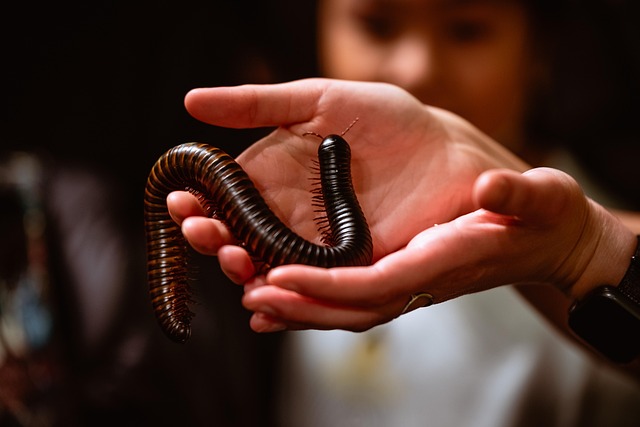Millipedes, though non-aggressive, can cause substantial damage through rapid population growth and home/garden destruction. Effective millipede control plans involve understanding their behavior, sealing entry points, maintaining drainage, and regular inspections with targeted treatments. Balancing chemical and non-chemical methods, like peppermint oil or diatomaceous earth, offers eco-friendly solutions. Proactive measures such as maintenance, cleaning, and lighting deter millipedes, while removing breeding grounds inhibits nesting. DIY options include essential oils and boric acid, but safety precautions are vital. Regular sealing and maintenance ensure long-term millipede control.
Millipedes can infiltrate homes, causing distress with their unusual appearance and potential damage to fabrics. This article offers comprehensive solutions for eliminating these pesky creatures through a multi-faceted approach. We’ll first ‘Understanding Millipedes’ to unravel their behavior and habitat preferences. Then, we’ll explore chemical and non-chemical control methods, providing effective millipede control plans. Additionally, learn valuable prevention and maintenance strategies, along with DIY solutions and safety tips for tackling infestations without professional intervention.
Understanding Millipedes: Behavior and Habitat
Millipedes are peculiar creatures, often misunderstood as they live primarily underground or in dark, moist places. They are not aggressive but can multiply rapidly, leading to infestations that can be both annoying and damaging to homes and gardens. Understanding their behavior is crucial for effective millipede control plans. These arthropods prefer humid environments, so areas with high moisture content, such as basements, crawl spaces, and lush vegetation, are prime real estate for them. They move slowly and mainly feed on decaying organic matter, but their presence can signal more severe issues like poor drainage or excessive moisture.
Knowing where they dwell is half the battle in millipede control. Their narrow bodies allow them to squeeze into tiny cracks and crevices, making it vital to inspect along foundations, inside corners, and behind appliances. Regular maintenance, including sealing entry points and keeping areas dry, can significantly deter millipedes. Effective millipede control plans often involve a combination of these preventive measures, regular inspections, and targeted treatments if an infestation is detected.
Chemical and Non-Chemical Control Methods
Millipede infestations can be effectively managed through a combination of chemical and non-chemical control methods. Chemical treatments involve the use of insecticides designed to target millipedes, applying them in strategic areas where millipedes are known to congregate. This approach offers quick results but must be used with caution, as improper application can have adverse effects on the environment and other non-target organisms.
Non-chemical control methods focus on preventing millipede access to hospitable environments. This includes sealing entry points, maintaining proper sanitation, and using natural repellents like peppermint oil or diatomaceous earth. These strategies are environmentally friendly and safe for use around homes with children and pets, making them a preferred choice for many. Together, these chemical and non-chemical control plans provide comprehensive millipede management solutions tailored to specific needs.
Prevention and Maintenance Strategies
Millipede control begins with proactive measures and maintenance strategies. Regularly inspecting your home and property for any signs of an infestation is crucial. Sealing entry points such as cracks, gaps in doors or windows, and utility pipes can prevent millipedes from entering your space. Maintaining a clean environment, particularly in areas where organic materials like leaves and grass clippings accumulate, goes a long way in deterring these pests. Additionally, keeping the exterior of your home well-lit can discourage millipedes from lingering nearby.
Implementing a comprehensive millipede control plan involves addressing potential breeding grounds. Removing sources of excessive moisture, such as leaky pipes or standing water, is essential, as millipedes thrive in humid conditions. Regularly trimming vegetation and clearing debris from around the perimeter of your property creates less favorable habitats for these creatures to nest and breed. Moreover, maintaining a well-mown lawn and raking leaves can make your outdoor spaces less inviting for millipedes to set up shop.
DIY Millipede Control Solutions and Safety Tips
If you’re looking for DIY millipede control solutions, there are several natural and chemical-based methods to consider. One popular approach involves using essential oils like peppermint, eucalyptus, or tea tree oil. These powerful scents act as repellents, effectively deterring millipedes from entering your home or garden. Another common method is applying boric acid powder along their likely entry points—such as cracks and crevices—as it’s toxic to these insects.
When implementing DIY millipede control plans, always prioritize safety. Wear protective gear like gloves and a mask when handling chemicals, and ensure good ventilation. Keep all products out of reach of children and pets. Additionally, be mindful that some methods may require repeated applications for optimal results. Regular maintenance and sealing entry points can significantly aid in long-term millipede control, even with do-it-yourself solutions.
Millipede infestations can be effectively managed through a combination of chemical and non-chemical methods, as well as proactive prevention and maintenance strategies. By understanding these creatures’ behavior and habitat, you can implement tailored millipede control plans to eliminate them. From professional treatments to DIY solutions, there are various options available. Remember, safety is paramount when dealing with chemicals, so always follow instructions carefully. With the right approach, it’s possible to keep millipedes at bay and enjoy a pest-free environment.
